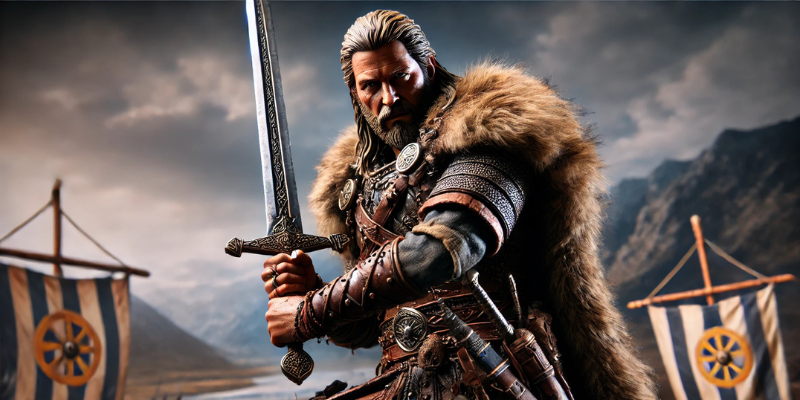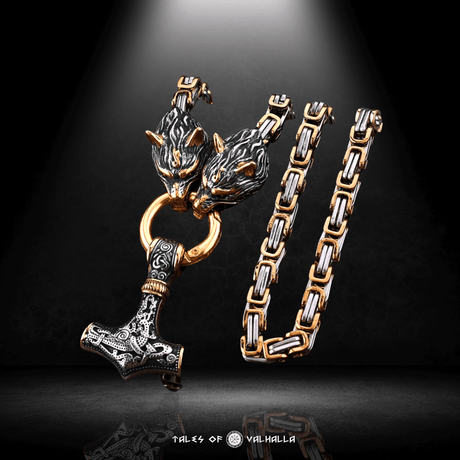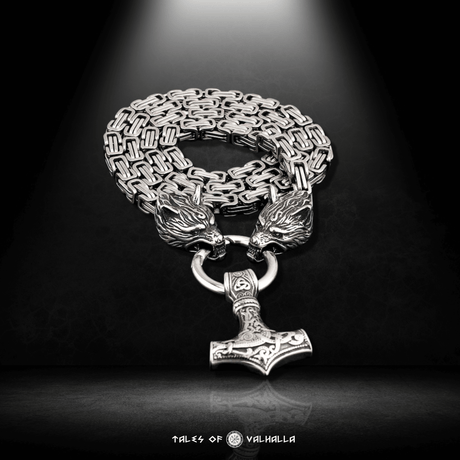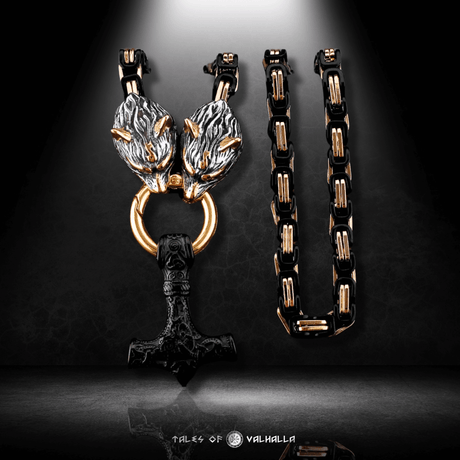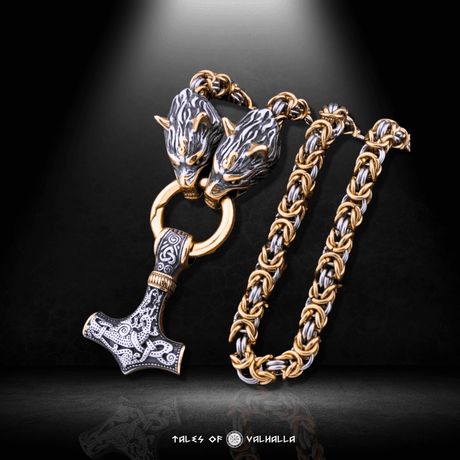The Viking sword stands as one of the most iconic symbols of Norse culture and warrior prowess. More than just a weapon, the Viking sword represented a warrior’s honor, skill, and social status. From its design to its battlefield effectiveness, the Viking sword was a testament to the craftsmanship and combat expertise of the Norse people.
In this comprehensive blog, we will delve deep into the history, significance, and evolution of the Viking sword. We'll explore how these swords were crafted, their role in battle, and what made them so revered. Whether you're interested in the historical importance or considering acquiring a Viking sword for sale, this guide will provide you with all the insights you need.
The History and Evolution of Viking Swords
Viking swords evolved over centuries, reflecting changes in technology, warfare, and social structures in the Norse world. While the sword was not the most common weapon (axes were more widespread), it held a special place in Viking culture, often seen as a mark of status and personal achievement.
Early Viking Swords
The earliest Viking swords were influenced by Roman and Frankish designs, particularly the spatha, a long, straight sword used by Roman cavalry. These early Viking swords were double-edged, with straight blades designed for both slashing and thrusting. As time went on, Viking swords became lighter, narrower, and more optimized for combat.
Early Viking swords had simple designs, often with a single metal type used for the entire blade. These swords were functional but lacked the artistic and metallurgical sophistication seen in later examples.

The History and Evolution of Viking Swords
The Evolution of Sword Craftsmanship
By the 9th and 10th centuries, Viking swordsmiths had significantly improved their techniques. Swords became more elaborate, with damascened blades made of multiple layers of steel that increased durability and flexibility. The Viking sword also became more ornate, with intricate designs on the pommel, cross-guard, and hilt.
One of the most famous types of Viking swords from this period is the Ulfberht sword, known for its superior craftsmanship and use of high-quality steel. These swords were often inscribed with the Ulfberht name, signaling that they were made by master swordsmiths. The quality of these blades gave Viking warriors a significant advantage in battle, as they were less likely to break or bend under pressure.
The Design of the Viking Sword
The design of the Viking sword was rooted in practicality, but it also carried symbolic importance. These swords were often passed down from generation to generation, becoming family heirlooms that carried the stories of their bearers. Let’s break down the essential components of the Viking sword and why each was crucial to its effectiveness.
Blade
The blade of a Viking sword was typically double-edged, measuring around 70-90 cm in length. Early Viking swords were relatively heavy, but later designs became lighter to improve speed and handling. The blades were designed for both slashing and stabbing, making them versatile weapons on the battlefield.
The blade's most important feature was its construction. Viking swords were often made using a technique called pattern welding, in which strips of iron and steel were twisted and hammered together to form a stronger, more flexible blade. This made the swords more resilient in battle, capable of withstanding significant impacts without breaking.
The Fuller
A key feature of many Viking swords was the fuller, a groove running along the center of the blade. The fuller was not simply decorative; it served a practical purpose by reducing the weight of the sword while maintaining its strength. The fuller allowed the sword to be more agile in combat, making it easier for a warrior to swing the blade quickly without sacrificing power.
Hilt and Pommel
The hilt of the Viking sword was often simple in design but sometimes featured intricate decorations, particularly on the pommel. The pommel served to counterbalance the weight of the blade, making the sword easier to control. Some pommels were highly ornate, featuring inscriptions or designs that reflected the warrior’s rank or achievements.
The grip of the sword was typically made from wood, wrapped in leather for a secure hold. A well-crafted hilt allowed the Viking warrior to maintain a firm grip during combat, ensuring that the sword could be wielded with both strength and precision.
Cross-Guard
The cross-guard of a Viking sword was usually straight and short, providing basic protection for the warrior’s hand. Unlike the elaborate cross-guards seen in later medieval swords, Viking cross-guards were minimalist in design. They were functional, preventing the enemy’s blade from sliding down the sword and injuring the hand, but they were not the sword's primary decorative feature.
The Viking Sword in Battle
Viking swords were not only beautifully crafted but also highly effective in combat. The sword was a weapon reserved for the elite, often worn by chieftains, nobles, and successful warriors. For Vikings, the sword was not only a tool of war but also a symbol of honor and personal achievement.

The Viking Sword in Battle
Combat Tactics with Viking Swords
While the Viking sword was not the most common weapon on the battlefield (axes and spears were more prevalent), it was one of the most effective. Viking warriors typically used swords in conjunction with shields, allowing them to defend against enemy attacks while delivering powerful slashes and thrusts.
Offensive Strikes
The Viking sword was ideal for both slashing and stabbing. Its double-edged blade allowed for quick, decisive strikes that could cut through armor, sever limbs, or incapacitate an opponent with a well-placed thrust. Unlike heavier weapons like the Dane axe, the Viking sword allowed for more precise attacks, making it a weapon of choice for close-quarters combat.
Defensive Techniques
In addition to its offensive capabilities, the Viking sword was an effective defensive tool. When used with a shield, the sword could parry enemy strikes, creating openings for counterattacks. Viking warriors were trained to use their swords strategically, blocking and deflecting attacks to wear down their opponents.
Ritual and Symbolism of the Viking Sword
The Viking sword was not just a weapon of war—it was a deeply symbolic object in Norse culture. Owning a sword was a mark of distinction, as swords were expensive to produce and often passed down through generations. A Viking warrior’s sword was often buried with him, signifying that the weapon would accompany him to Valhalla, the hall of slain warriors.
Viking swords were also engraved with runes or other symbols, reflecting the warrior’s beliefs, lineage, or achievements. These inscriptions added to the sword’s symbolic power, making it a representation of the warrior’s strength and honor.
- See more: Viking Battle Axes: Tools of War
Viking Swords for Sale: Acquiring Your Own Piece of History
In modern times, owning a Viking sword allows enthusiasts and collectors to connect with the rich history and legacy of the Norse people. Whether you’re a collector, historical reenactor, or simply a fan of Viking culture, there are many Viking swords for sale that cater to different needs.

Viking Swords for Sale
Types of Viking Swords Available for Purchase
When looking for Viking swords for sale, you’ll encounter several different types, ranging from authentic historical replicas to modern interpretations. Here are the most common types of Viking swords available:
Authentic Replicas
Authentic replicas are carefully crafted to match the design and construction techniques of real Viking swords. These swords are often made using high-quality materials such as Damascus steel and feature historically accurate details like the fuller, cross-guard, and pommel. These replicas are ideal for historical reenactments or display purposes.
Functional Swords
For those looking for a Viking sword that can be used in combat or training, functional swords are available. These swords are designed for use in activities like stage combat or HEMA (Historical European Martial Arts), and they’re built to withstand impact. Functional Viking swords often have blunted edges to ensure safety during sparring but retain the weight and balance of a real sword.
Decorative Swords
Decorative Viking swords are intended for display rather than use. These swords often feature intricate engravings and designs, making them beautiful pieces for collectors. While they may not be functional for combat, they capture the spirit and aesthetic of the Viking sword.
Choosing the Right Viking Sword
When purchasing a Viking sword, it’s important to consider your specific needs and preferences. Whether you’re looking for a functional sword for reenactments or a decorative piece for your collection, here are some key factors to keep in mind:
Blade Material and Construction
The material and construction of the sword’s blade are crucial for both aesthetics and functionality. Authentic Viking swords were often made using pattern-welded steel, which created a distinctive wavy pattern on the blade. Modern swordsmiths use similar techniques to replicate this pattern, ensuring that the sword is both strong and visually striking.

Blade Material and Construction
Handle and Grip
A well-crafted handle is essential for ensuring that the sword is comfortable to wield. Look for swords with a grip made from high-quality wood or leather, which will provide a secure hold during use. The pommel should also be well-balanced, allowing you to control the sword’s movements easily.
Purpose of the Sword
Consider how you intend to use the sword. If you’re looking for a functional sword for combat or training, prioritize durability and weight balance. If the sword is primarily for display, focus on craftsmanship and design details that make the sword stand out.
The Legacy of the Viking Sword
The Viking sword remains an enduring symbol of honor, strength, and craftsmanship. From its early origins to its role in Viking society and warfare, the sword has captured the imagination of historians, reenactors, and enthusiasts worldwide. As a tool of war and a mark of status, the Viking sword has earned its place in the annals of history.
The Viking Sword in Modern Culture
Today, Viking swords are featured prominently in popular culture, from movies and television shows to video games and historical documentaries. The sword’s distinctive design and rich history continue to inspire modern audiences, drawing attention to the craftsmanship and skill required to create such a powerful weapon.
Whether you’re exploring the history of the norse sword or considering adding a Viking short sword to your collection, the Viking sword continues to offer a fascinating glimpse into the world of the Norse people.

